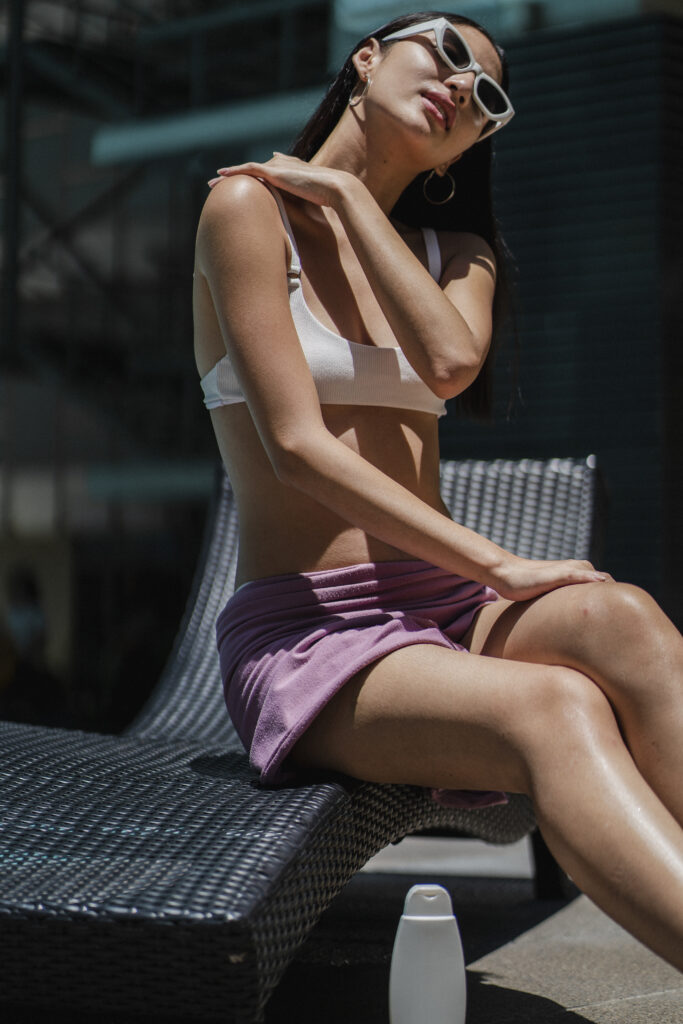If you’re considering undergoing phototherapy for a skin condition, you may be wondering if there’s a potential for a tan or sunburn. Well, good news! In this article, we’ll explore the effects of phototherapy on your skin and whether or not you need to worry about a tan or sunburn. So, sit back, relax, and let’s shed some light on this topic!
The Basics of Phototherapy
Definition of Phototherapy
Phototherapy, also known as light therapy, is a medical treatment that utilizes specific wavelengths of light to treat various health conditions, particularly those affecting the skin. It involves exposing the skin to either natural or artificial light sources for a specified duration and intensity. This therapeutic modality has been proven effective in managing conditions such as psoriasis, eczema, vitiligo, and jaundice in newborns.
Types of Phototherapy
There are different types of phototherapy used in medical practice, each employing specific light wavelengths and sources. The most common forms of phototherapy include UVB (Ultraviolet B), UVA (Ultraviolet A), narrowband UVB, PUVA (Psoralen plus Ultraviolet A), and UVB laser. Each type of phototherapy has its own unique benefits and indications. UVB phototherapy, for instance, is commonly used to treat psoriasis and vitiligo, while UVA phototherapy is often used in combination with psoralen for the treatment of psoriasis, vitiligo, and eczema.
How Phototherapy Works
Phototherapy works by penetrating the skin and interacting with various components, such as the DNA in the skin cells. Different wavelengths of light have different effects on the skin. For example, UVB light slows down the rapid growth of skin cells, reducing inflammation and relieving symptoms of conditions like psoriasis. UVA light penetrates deeper into the skin, impacting the immune system and enabling the release of certain chemicals that help treat certain skin conditions. The precise mechanisms of how phototherapy works are still being studied, but it is believed to involve immunomodulatory effects, anti-inflammatory properties, and regulation of cell division.
Understanding Tanning
What Causes Tanning?
Tanning is a natural response of the skin to ultraviolet (UV) radiation exposure, which can come from sunlight or artificial sources such as tanning beds used in phototherapy. When the skin is exposed to UV radiation, it triggers the production of a pigment called melanin. Melanin is responsible for giving color to the skin, hair, and eyes. The more melanin produced, the darker the skin becomes in an attempt to protect itself from further UV damage.
Mechanism of Melanin Production
Melanin is produced by specialized cells called melanocytes, which are present in the epidermis, the outermost layer of the skin. When exposed to UV radiation, melanocytes produce more melanin and transfer it to neighboring skin cells, resulting in a darker complexion. This mechanism is a protective response to shield the DNA in the skin cells from the harmful effects of excessive UV radiation.
Effects of UVA and UVB Rays on the Skin
Both UVA and UVB rays contribute to tanning, but they have different effects on the skin. UVA rays are longer and have a greater ability to penetrate the skin compared to UVB rays. They are primarily responsible for immediate tanning, as they can darken existing melanin in the skin. UVB rays, on the other hand, are shorter and mostly absorbed by the epidermis. They stimulate the production of new melanin, leading to a delayed tan. However, it is important to note that both UVA and UVB rays can damage the DNA in skin cells, increasing the risk of sunburn and long-term skin damage.

Potential for Tanning in Phototherapy
UVA vs. UVB Phototherapy
In the context of phototherapy, both UVA and UVB rays can be used to induce therapeutic effects. Depending on the specific condition being treated, the healthcare provider may prescribe either UVA or UVB phototherapy. UVB phototherapy is commonly used for conditions such as psoriasis and vitiligo, while UVA phototherapy, used in combination with a medication called psoralen, is often prescribed for conditions like psoriasis, vitiligo, and eczema. While both types of phototherapy can result in some degree of tanning, UVB tends to induce more immediate tanning effects, while UVA-based treatments may lead to a delayed tan.
The Role of UVA in Tanning
UVA rays used in phototherapy can contribute to the tanning process by darkening existing melanin in the skin. However, the UVA dosage used in controlled phototherapy settings is carefully monitored to minimize the risk of sunburn while still providing therapeutic benefits. It is important to remember that the primary objective of phototherapy is to treat a specific medical condition and not to achieve a tan. Tanning can be an unintended side effect of phototherapy, and the healthcare provider will take precautions to ensure that the treatment remains safe and effective.
The Role of UVB in Tanning
UVB rays used in phototherapy can stimulate the production of new melanin in the skin, resulting in a tan. This tanning response to UVB radiation is similar to the natural tanning process when exposed to sunlight. However, like UVA, UVB dosage in phototherapy is carefully calculated and monitored to prevent sunburn and minimize the risk of long-term damage. The healthcare provider will tailor the treatment protocol to achieve optimal therapeutic effects while minimizing the potential for unwanted tanning and associated risks.
Factors Affecting Tanning
Dose and Duration of Phototherapy
The dose and duration of phototherapy treatment sessions play a crucial role in determining the extent of tanning. Healthcare providers carefully prescribe the appropriate dosage and treatment duration based on individual factors such as skin type, condition being treated, and the desired therapeutic outcome. By adjusting these parameters, providers can minimize or control the level of tanning that occurs during phototherapy.
Skin Type and Sensitivity
Different skin types have varying degrees of sensitivity to UV radiation and may require different approaches to phototherapy. Fair-skinned individuals with less melanin may be more prone to sunburn and tend to tan more easily. People with darker skin may have a higher natural protection against sunburn but can still experience tanning. Healthcare providers take into consideration the patient’s skin type and sensitivity to ensure safe and effective phototherapy treatment.
Use of Protective Measures
To reduce tanning and minimize the risk of sunburn during phototherapy, protective measures should be taken. These may include wearing protective clothing, such as long sleeves and pants, or using broad-spectrum sunscreen with a high sun protection factor (SPF). Protective eyewear is also essential to shield the eyes from potential UV damage. By implementing these precautions, individuals can help mitigate the tanning effects and reduce the potential risks associated with phototherapy.

Sunburn and Phototherapy
Difference Between Sunburn and Tanning
Sunburn and tanning are two distinct responses of the skin to UV radiation. Tanning is the skin’s natural defense mechanism against UV damage, resulting in the darkening of the skin due to increased melanin production. In contrast, sunburn occurs when the skin is exposed to excessive amounts of UV radiation, leading to damage of DNA within skin cells. Sunburn presents as redness, pain, swelling, and, in severe cases, blistering of the affected skin.
Potential Risks of Sunburn in Phototherapy
While phototherapy is carefully administered to minimize the risk of sunburn, it is still possible to experience sunburn if the recommended safety measures are not followed. Sunburn can occur if the treatment duration, dosage, or protective measures are inadequate. Sunburn can also be more likely in individuals with fair or sensitive skin. It is important to notify the healthcare provider if any signs of sunburn or skin irritation occur during or after phototherapy sessions.
Prevention and Management of Sunburn
Prevention is key when it comes to avoiding sunburn during phototherapy. Individuals should adhere to the recommended treatment protocols, which may involve gradually increasing the treatment duration and dose over time. Protective measures, such as using sunscreen, wearing protective clothing, and utilizing appropriate eyewear, should be followed diligently. If sunburn does occur, it is important to inform the healthcare provider and seek appropriate management, which may include soothing topical treatments, hydration, and temporary adjustment of the phototherapy protocol.
Importance of Monitoring
Regular Skin Assessments
Regular skin assessments are essential during phototherapy to monitor tanning, potential side effects, and the overall progress of the treatment. Healthcare providers will often conduct skin assessments before, during, and after phototherapy sessions to identify any changes or issues that may require adjustments to the treatment plan. By closely monitoring the skin, providers can ensure that the desired therapeutic outcomes are achieved while minimizing adverse effects.
Monitoring UV Exposure
In addition to assessing the skin, monitoring UV exposure is crucial to prevent overexposure and potential complications. Healthcare providers will keep a record of the cumulative UV dose received by the patient and adjust the treatment parameters accordingly. This monitoring process helps prevent excessive tanning, sunburn, and long-term damage to the skin.
Collaboration with Healthcare Providers
Open communication and collaboration with healthcare providers are essential throughout the phototherapy treatment process. Patients should inform their healthcare providers about any concerns, changes in skin condition, or unexpected reactions. Healthcare providers can then provide the necessary guidance, support, and adjustments to ensure a safe and effective phototherapy experience.

Safer Alternatives to Tanning
DHA-Based Self-Tanners
Dihydroxyacetone (DHA)-based self-tanners are a popular alternative to achieving a tan without the need for UV exposure. DHA is a colorless sugar that reacts with amino acids present on the skin’s surface, resulting in a temporary artificial tan. These self-tanners come in various forms such as lotions, sprays, and foams, and they provide an immediate tanning effect that lasts for a few days. DHA self-tanners are considered safe and do not carry the same risks associated with UV exposure.
Bronzers and Temporary Tanning Solutions
Bronzers and temporary tanning solutions provide an instant tan without any UV exposure. These products contain pigments that temporarily darken the skin, similar to makeup. Bronzers and other temporary tanning solutions are available in different formulations, including creams, powders, and sprays. They provide a quick and temporary tan that can be washed off, making them ideal for special occasions or for those who prefer not to undergo UV exposure.
Tanning Pills and Injections
Tanning pills and injections are options that claim to stimulate melanin production without the need for UV exposure. However, their safety and effectiveness are still subject to debate. Tanning pills usually contain canthaxanthin, a color additive used in food, while tanning injections may consist of synthetic Melanotan peptides. Both methods carry potential risks and may not provide reliable or safe alternatives to natural or UV-based tanning methods. It is crucial to consult with a healthcare professional before considering these options.
Safe Practices in Phototherapy
Professional Guidance and Supervision
Phototherapy should always be performed under the guidance and supervision of a healthcare professional experienced in the field. Only trained professionals can determine the most appropriate treatment parameters, monitor the progress, and ensure the overall safety and efficacy of the therapy. Collaboration with healthcare providers is essential to achieve the desired therapeutic outcomes while minimizing potential risks.
Proper Use of Protective Eyewear
Protective eyewear is an essential component of safe phototherapy. The eyes are highly sensitive to UV radiation and can be susceptible to damage if not adequately shielded. Specialized goggles or glasses designed for phototherapy should be worn during each treatment session to protect the eyes from potential harm. It is essential to follow the healthcare provider’s instructions on the proper use and care of protective eyewear.
Skin Care and Moisturization
Proper skin care and moisturization are essential during phototherapy to minimize the risk of skin damage, dryness, and irritation. Patients should follow their healthcare provider’s recommendations regarding skincare products and practices. Regular use of moisturizers can help maintain the skin’s integrity and prevent excessive dryness or flaking, which can be aggravated by phototherapy. It is advisable to use gentle, fragrance-free products that are specifically formulated for sensitive skin.
Potential Side Effects
Common Skin Reactions
Like any medical treatment, phototherapy can have potential side effects. Common skin reactions may include erythema (redness), dryness, itching, and mild skin irritation. These reactions are often temporary and subside with time or appropriate interventions. Proper skincare practices, moisturization, and following the recommended treatment protocols can help minimize these side effects.
Rare Adverse Effects
In rare cases, phototherapy may lead to more severe adverse effects such as blistering, severe burns, or changes in pigmentation. These reactions are relatively uncommon but can occur, particularly if the treatment parameters are not appropriately adjusted or if the patient has underlying conditions that make them more susceptible to adverse reactions. It is essential to report any unusual or prolonged side effects to the healthcare provider for further evaluation and management.
Allergic Reactions and Photosensitivity
Some individuals may experience allergic reactions to certain phototherapy equipment, medications, or skincare products used in conjunction with the treatment. It is important to inform the healthcare provider of any known allergies or sensitivities to avoid potential reactions. Additionally, phototherapy can make the skin more sensitive to sunlight and artificial light sources, even after treatment. This heightened sensitivity may increase the risk of sunburn or other adverse reactions. Protective measures, such as avoiding unnecessary UV exposure, should be followed after phototherapy sessions.
Consultation and Individualized Approach
Understanding Personal Risk Factors
Before undergoing phototherapy, a thorough consultation with a healthcare provider is essential to assess individual risk factors. The healthcare provider will review the patient’s medical history, assess their skin type and sensitivity, and consider any existing conditions that may impact the choice of phototherapy and associated risks. By taking these factors into account, the healthcare provider can develop an individualized treatment plan that maximizes benefits and minimizes potential side effects.
Customized Phototherapy Protocols
Phototherapy protocols should be tailored to each individual’s specific needs and condition being treated. Treatment parameters, such as light intensity, duration, and frequency, should be carefully determined based on factors including the patient’s skin type, condition severity, response to previous treatments, and overall health. Individualizing the protocols ensures that the treatment remains safe and effective, optimizing the likelihood of positive outcomes while minimizing adverse effects.
Open Communication with the Healthcare Team
Effective communication with the healthcare team is crucial throughout the course of phototherapy. Patients should openly discuss any concerns, changes in their condition, or unexpected reactions with their healthcare provider. This communication helps the healthcare team monitor progress, assess treatment efficacy, and make appropriate adjustments if needed. Regular follow-up appointments and consultations allow for ongoing evaluation and refinement of the phototherapy plan, ensuring the best possible outcomes for the patient’s overall well-being.
In conclusion, phototherapy has proven to be an effective treatment for various skin conditions. While tanning can be an unintended side effect of phototherapy, it is essential to prioritize the therapeutic benefits over achieving a tan. Proper monitoring, adherence to treatment protocols, use of protective measures, and open communication with healthcare providers are crucial for ensuring the safety and effectiveness of phototherapy. If you have any concerns or questions about phototherapy, consult with a healthcare professional experienced in dermatology or phototherapy to receive personalized guidance and appropriate care.